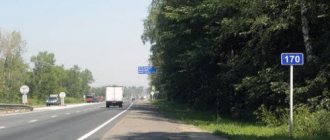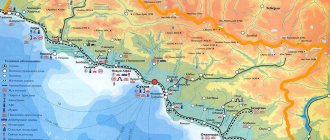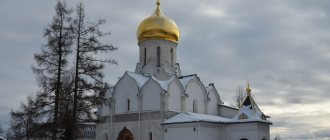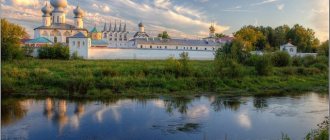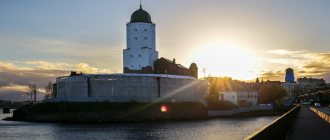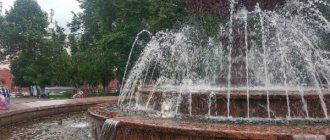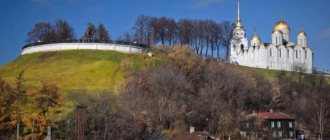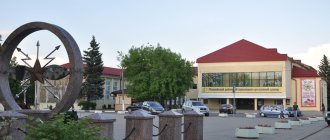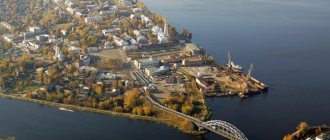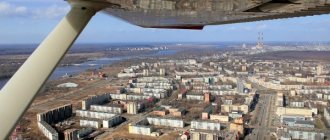Hello, friends, have you arrived in Kaliningrad and don’t know what to do with yourself? Don't worry! In this article I will tell you about the popular attractions of Kaliningrad with photos, names and descriptions, as well as prices. You will find out what you can see in Kaliningrad in 1,2,3 and 5 days and where to go, as well as what interesting excursions in Kaliningrad and the Kaliningrad region are best to visit to feel the atmosphere of the city.
Kaliningrad is a wonderful city, full of sights, museums and, of course, excursions. Now I will tell you about the main tourist spots of the city.
Kant Island
The first attraction we will see is Kant Island.
Perhaps this is the most famous place in Kaliningrad. All excursions most often start from here. The island is named after the famous thinker Immanuel Kant; this is where his grave is located. There is even an opinion that for this reason the Cathedral - one of the pearls of the city and the former East Prussia as a whole - was not completely destroyed. Although many other places of worship suffered precisely this fate.
However, it is not entirely accurate to say that the cathedral was not destroyed. On August 20, 1944, Koenigsberg was bombed by British aircraft. Either the British wanted to take revenge for the destroyed sights of London, or the reason was more pragmatic. They said that it was on the island of Kant that there was a secret fascist laboratory where “secret weapons” were being developed using various technologies based on ancient magic. Be that as it may, as a result of the bombing, the Royal Castle and the Old Town were destroyed, and the Cathedral was seriously damaged. However, after the end of the war, when Koenigsberg was annexed by the Soviet Union, the ruins of the cathedral were not demolished. After all, it was there that Immanuel Kant was buried, who enjoyed great respect from Vladimir Lenin.
This ruin stood there for almost half a century, and only at the turn of the 20th and 21st centuries the architectural monument began to be restored.
On the island you can see the tomb of Immanuel Kant . More precisely, it is not exactly a grave, it is a pink colonnade and a chapel in the neo-Gothic style. They appeared at the beginning of the 20th century. Inside the colonnade is a cenotaph - a false tomb; in fact, Kant's remains rest in the ground below.
In addition, on Kant Island they examine the monument to Duke Albrecht , the founder of the university; The statue was installed in 2005.
It is also interesting to see the Honey Bridge , which leads to Kant’s bonfire. It was named so because in the old days the townspeople, seeking the construction of this bridge, gave the city administration a bribe - a barrel of honey.
Here on the island you can see another interesting monument. This is a monument depicting the young Peter I ; it is located near the entrance to the Cathedral.
Forts of Koenigsberg
Fort No. 1 Stein
The forts of Kaliningrad are a ring of defensive structures of the city, the so-called “night feather bed of Konigsberg”. The ring consisted of 12 large and 3 small forts located at a distance of approximately 5 km from the city and protecting the approaches to it.
The forts of Kaliningrad were built at the end of the 19th century and were useful to the Germans only during World War II in 1945, when the Red Army approached Konigsberg. Because of the fort system, Soviet soldiers had a difficult time storming the city. A medal was given for the capture of Koenigsberg; it is noteworthy that this is the only medal that was not given for the capture of the capital. More than two hundred people participating in the assault on the city became Heroes of the Soviet Union.
Fort No. 5 King Frederick William III
Now some of the forts are abandoned, some have been turned into museums. Fort No. 5 King Friedrich Wilhelm III was the luckiest of all - in 1973 it became a branch of the Kaliningrad Regional History and Art Museum. Anyone can come and see the fort.
Another most popular and accessible fort is Fort No. 11 Denhoff.
Fort No. 11 Denhoff
Cathedral
Of course, the Cathedral, restored in our century, is the main attraction of Kant Island. Construction began in 1333 and lasted 80 years. In the 19th century, the cathedral was strengthened with a concrete base, as the architect decided that the ground under the cathedral was subsiding; If not for this, most likely, only ruins would remain of the cathedral.
The cathedral is not active, but inside there are two chapels where services are sometimes held—Orthodox and Evangelical. The main square is used as a museum and concert hall. One of the largest organs in Europe is located here . There is another one - a small one. Evening and daytime concerts of classical and religious music and organ competitions are regularly held. Within the walls of the cathedral there are tombstones of honorary citizens.
It is better to visit the cathedral with a guide: without the help of a specialist, it is difficult to understand what is located here and what historical events are displayed in the exhibits.
Another attraction of the island is the Sculpture Park . Here you can see 23 images made in different styles, but on the general theme “Man and the World”.
- Opening hours of the Cathedral: Monday - Thursday: 10:00 - 18:00. Friday – Sunday: 10:00 – 19:00. The day off is January 1st.
- Cost of visiting : Museum: adults 150 rubles, pensioners 100 rubles, schoolchildren and students - 50 rubles; concerts: evening 450 rub., daytime 350 rub. Benefits available. Read more about prices, benefits and special offers here
- Address : Kaliningrad, st. I. Kanta, 1.
- How to get there : by bus 1, 3, 7, 8, 9, 10, 11, 12, 14, 17, 18, 19, 21, 23, 27, 30, 36, 37, 44, 49, 159, 106, 108 to the stop “House of Culture for Sailors”; by trolleybus 2, 7 to the stop “SK Yunost”; by minibus T72, T80, T92 to the “Rybnaya Derevnya” stop.
- Tel.: +7 (4012) 631-705.
- Website
Attractions in the surrounding area
Curonian Spit
GPS coordinates: 55.235530, 20.916837 Address: Zelenograd urban district Telephone: Website: https://www.park-kosa.ru/ hours: 24 hours Cost: 150 rubles How to get there: 43 km by car from Kaliningrad towards Zelenogradsk; There is a direct bus from the bus station to the national park, travel time - 1 hour
The spit stretches for almost 100 km, the territory belongs to two countries: Russia and Lithuania. Traveling through spruce forests and sand dunes, you can swim in the Baltic Sea and the Curonian Lagoon.
Since 1987, one of the smallest national parks in Russia opened on the territory.
The main attractions of the reserve:
- the Royal Forest ecological trail, where moose and deer roam freely;
- lighthouse 50 m high;
- Lake Chaika - the waters are inhabited by perch, crucian carp, pike, fishing is allowed;
- the route from Rossitern to Rybachy is dedicated to the history of the largest settlement on the spit;
- a chapel in memory of the dead fishermen;
- ornithological station "Fringilla";
- Church of St. Sergius of Radonezh 1873
Height of Efa
GPS coordinates: 55.221150, 20.906393. Address: Curonian Spit Phone: Website: https://www.park-kosa.ru/ Opening hours: around the clock Cost: 150 rubles How to get there: 43 km by car from Kaliningrad towards Zelenogradsk; There is a direct bus from the bus station to the national park, travel time - 1 hour
Located in the Curonian Spit, the height is one of the highest dunes in Europe. The road to Efa rises 3 km; at the top there are two observation platforms.
You can hear the “singing sands” here.
The height was named in honor of Franz Ef, the initiator of forest planting on the Curonian Spit.
Waldau Castle
GPS coordinates: 54.700504, 20.742975 Address: Nizovye village, st. Kaliningradskaya, 20a Phone: Website: https://waldauschloss.ru/ Opening hours: 10.00-17.00 Tue-Sun, Mon - day off Cost: 100 rubles How to get there: 20 km by car from Kaliningrad along the A229 highway; from the rest “Ushakovo” in Kaliningrad, in the village of Nizovye there is bus No. 110, travel time is 30 minutes
The castle near Lithuania was built by the Prussian princes Diabel and Brulant in 1264. The land for the fortress was given to the nobles by the Grand Master for loyalty to the Teutonic Order. Since 1870, only educational institutions have been located in Waldau - thanks to this, the castle has been well preserved.
Since 2014, a museum has been opened in the castle. There are 5 exhibitions in 4 halls:
- archaeological with objects found on the territory of Waldau;
- Teutonic Order with armor and weapons of knights;
- Prussian with antique household items;
- dedicated to the visit of the castle by Peter I;
- telling about the Napoleonic, First and Second World Wars.
If you have not yet chosen where you will live and want to save money when booking, we recommend using the RoomGuru service. Firstly, it contains hotels, apartments and guest houses from many different booking systems, so you won’t miss out on a worthwhile option. Secondly, you can immediately compare prices for one place in different services and book where it is cheaper (this is not always Booking!).
Fishing village
Crossing the Honey Bridge, we find ourselves in the Fish Village. This is a kind of shopping complex, which is located between the Medov and Yubileiny bridges (Yubileiny Bridge is the youngest and, perhaps, the most beautiful of the bridges in Kaliningrad). The fishing village is a whole town, stylized as an antique. It was built in 2006. In the past, there was a market where they sold fish. This, apparently, gave rise to the idea of creating a Fish Village.
The buildings that can be seen in the Fish Village are stylized as old German architecture and decorated with beautiful paintings. Here you can wander around with pleasure, admiring the amazing buildings, or you can climb the Mayak view tower , which offers a magnificent view of the entire city.
Inside the towers you can take great photos of both the views and your own with various small sculptures (Skipper and the like). A small sculpture of a seagull is also installed here. It is generally accepted that you need to rub the iron beak of a bird for good luck. Here, in a small coffee shop, you can drink a cup of coffee, and also stroll along the open gallery connecting the Mayak with the hotel, which is located nearby.
In the Fish Village there is also a business center, several hotels and entertainment complexes, as well as another view tower - Lomze.
- Cost of visit : free; observation tower "Mayak" - 100 rubles.
- Address : Kaliningrad, st. Oktyabrskaya, 2.
- How to get there : minibus No. 72
Parks
Interesting sights of Kaliningrad are not only numerous museums and exhibitions, but also Kaliningrad parks. Some parks have all kinds of attractions where you can have fun with children: Yunost Park, Central Park of Culture and Recreation (CPKiO), South Park.
In some parks it’s good to just walk near bodies of water: Max Aschmann Park or among beautiful unusual plants: Botanical Garden, Sculpture Park.
Kaliningrad has the oldest zoo in the country. It was founded by German entrepreneur Hermann Klaass in 1896. In the center of the zoo there is a beautiful fountain with a jet height of up to 18 meters; there is also an arboretum.
Kreuzkirche
After visiting the Fishing Village, you can go see the most beautiful monument of ancient architecture - the Church of the Cross , in German Kreuzkirch. The building was once decorated with images of pelicans, which in medieval Germany were considered symbols of self-sacrifice. However, these images have not survived.
The church is built from the so-called clinker - bricks of varying degrees of firing, due to which the walls appear multi-colored. The building was erected in 1933, but the temple was saved from destruction by the fact that it constantly housed some kind of industrial premises. And only in 1990 the church again became a place of worship, but it was reconsecrated as an Orthodox church and is now called the Cathedral of the Exaltation of the Cross of the Kaliningrad Diocese. a unique altar was installed in the temple ; it is made of amber. It is worth visiting the cathedral and admiring it.
- Opening hours : Monday - Friday 09:00-17:00, Saturday 09:00-20:30, Sunday 07:00-20:30.
- Address : Kaliningrad, st. Generala Pavlova, 2.
- How to get there : on foot from the Fishing Village (the cathedral is located in the depths of the building, it is difficult to see from the street).
- Tel..
- Website
Souvenirs
What to bring home from Kaliningrad as a souvenir? Of course, the stone of the sun is amber in all its forms: jewelry, cosmetics, objects made of amber. As well as local Baltic fish (the most popular: smoked eel and sea bream), marzipan, Old Koenigsberg cognac and antiques.
And of course, traditional Kaliningrad souvenirs: souvenir plates and magnets with views of Kaliningrad or Koenigsberg. A distinctive feature of local souvenirs: amber decoration.
Church of the Holy Family
We will walk back along the Jubilee Bridge. Following Bagration Street and soon turning onto Krasnoarmeyskaya Street, we will see another famous religious building - the Church of the Holy Family .
Built in the neo-Gothic style, the most famous and spectacular Catholic religious building is now no longer a church, but a concert hall. The building is extraordinarily beautiful; it resembles an ancient knight's castle with many small and one large tower. The acoustics inside are amazing, so it's no surprise that this place now hosts concerts. After the war, the dilapidated building was not restored for a long time and only at the end of the 20th century the organ was installed again. regular concerts and organ music festivals now take place .
- Opening hours : 9:00 – 16:00 daily
- Cost of attendance : concerts - from 350 rubles.
- Address : Kaliningrad, st. Bogdan Khmelnitsky, 61A.
- How to get there : use a variety of transport to stops “pl. Kalinina" or "st. Bagration".
- Tel.
- Philharmonic website (organ music concerts and more):
Monument to Kalinin and South Station
Now we will walk through the Soviet-Polish Friendship Square, take a walk in the charming park named after the 40th anniversary of the Komsomol and soon we will find ourselves near the South Railway Station, where we can examine the station itself and the monument to Kalinin. Both are of historical rather than artistic value.
The station was built in 1929; Trains departed and depart from here to different cities of the Russian Federation and abroad. The Museum of the History of the Kaliningrad Railway is open on the territory of the station . The station was the first building to be hit by Soviet bombs when a retaliatory strike was launched after the bombing of Kyiv.
All-Union Elder Kalinin is, naturally, the man after whom the city is now named.
- Address : Kaliningrad, Zheleznodorozhnaya st., 29.
- Tel.
Brandenburg Gate
Of course, it is impossible to leave Kaliningrad without visiting the famous Brandenburg Gate.
This is one of the most ancient attractions; it has come down to us since Prussian times, and the gate not only survived despite the wars, but also retained its function.
They were built in the 17th century and initially served a defensive function. Nowadays there are small shops in the interior. But the main function of the gate is still not commercial, but aesthetic. Well, as already mentioned, a road and tram tracks pass through them.
, 8 gates have survived in Kaliningrad . The rest of the gates (Sackheim, Royal, Rossgarten, Friedrichsburg and so on now) are simply decoration and a reminder of the past.
- Opening hours : 24 hours a day.
- Address : st. Bagrationa, no. 160.
- How to get there : walk from the South Station.
Sightseeing tours
It would seem that a small city, which has long been visited far and wide by tourists, can be easily explored on its own. And yes, that's true. But there are always non-trivial excursions, a desire to listen to a guide and learn from him the history of the city, as well as a simple lack of time. How to see all the best in 1 day or even in a few hours? Choose sightseeing or narrow, thematic excursions.
For example, along with express must-see routes, guides in Kaliningrad offer a closer look at the truly German districts of Amalienau and the lesser-known Maraunenhof - or rather, the preserved part of it near the Upper Pond. Interesting museum routes with guided tours, themed walks around the city, legends about Kaliningrad dungeons.
City tours on the project Experts.Tourister.Ru
One of the German houses in the Amalienau area Photo: © Chiffa7
St George's Hospital
After visiting the Brandenburg Gate, it is best to walk further along Bagration Street, and then turn north and explore another medieval building preserved in Kaliningrad. This is the building of St. George's Hospital; it now houses a marine fisheries college.
The dark red building, very reminiscent of a fairy-tale castle, was once a city leper colony, and later a military hospital. It is interesting that it was in this hospital that Richard Sorge was once treated, at that time an ordinary German soldier - the same Sorge who later became a famous intelligence officer.
- Address : Kaliningrad, st. Morekhodnaya, 3
- How to get there : walk from Leninsky Prospekt, turn onto the street. Krasnooktyabrskaya, and then on the street. Seaworthy.
Reviews from tourists about shopping - where is it better?
There are many shops in Kaliningrad. Even IKEA will open soon (according to rumors). The most famous shopping center is Europe. Located in the center, opposite Victory Square. Most well-known brands are represented.
Shopping center Europe & shopping center Kaliningrad
Opposite the Kaliningrad hotel is the shopping center (you'll never guess!) Kaliningrad! Another large shopping + business center is Clover Citycenter (in the same building as the Radisson Hotel Kaliningrad).
A popular supermarket in the Kaliningrad region is SPAR (I haven’t seen any others, just different stalls/tents). No Fives made it here.
Prices in Kaliningrad are Russian. Lower than in Moscow or Sochi, slightly higher than in completely non-tourist cities.
Exchange building
This architectural structure is not only very beautiful, but also famous for the fact that there was once a concert hall here, where Liszt, Schumann, Rubinstein and other famous composers set foot.
Built in the century before last in the neoclassical style, the building is very picturesque; it was restored only in the 1960s; Films were filmed here, and now this building is a youth center.
- Address : Kaliningrad, Leninsky Prospekt, 83.
- How to get there : walk along Leninsky Prospekt.
- Tel . (Youth Culture Center): +7 (4012) 64-34-38.
House of Soviets
The House of Soviets is a symbol of Soviet Kaliningrad. The locals call it “robot”, it really looks like it. The grandiose 21-story building was supposed to house all the government structures of the city. Construction began in 1970, but has not yet been completed.
Tourists used the House of Soviets to climb onto the roof and admire the city from above. The event is not safe, there are no elevators in the building, you had to walk up. The territory of the building is fenced and guarded, but the guard allowed those who wanted to enter for a modest fee.
Now for the 2022 FIFA World Cup the situation has changed. The area around the House of Soviets has been landscaped, a new fence has been installed, and tourists are now prohibited from entering.
Friedrichsburg Gate
This amazing landmark is not just a beautiful building; the building is connected with our history.
Built in the 17th century, the gate led to a fortress also called Königsberg. It is interesting that it was here, under the guise of Peter Mikhailov, that the young Emperor Peter the Great studied artillery ; Upon completion of his studies, Pyotr Mikhailov received a certificate of “skilled firearms artist.”
The Rook House Museum is located on the territory of the gate . Here, in fact, ancient ships (longships) are built using ancient technologies. There are now exhibitions near the gate: you can see cannons and other weapons; Here you can also see museums dedicated to sea vessels, see models of ships, various navigational instruments, and view an exhibition dedicated to sunken ships.
- Opening hours : Wednesday – Sunday 10:00–18:00.
- Cost of visiting the museum: adult - 200 rubles, single ticket (adult + 1 child) - 300 rubles, single ticket (adult + 2 children) - 400 rubles.
- Address : Kaliningrad, st. Portovaya, 39a.
- Tel . (museum) +7 4012 63‑27-42, +7 4012 63‑27-39.
- How to get there : by bus No. 4, 117 to the Gidrostroy stop
- Website
Museum of the World Ocean
Another interesting attraction of Kaliningrad is the Museum of the World Ocean, which contains a rich collection of exhibits. Some of them are located in the open air; you can view them without buying a ticket to the museum.
The main building of the museum houses aquariums, a laboratory, and a souvenir shop. Here you can see the instruments of oceanographers, as well as various sea creatures.
In the area next to the museum you can see the so-called Science Square , which houses several interesting interactive exhibits. For example, there is a pavilion that demonstrates echo in spherical rooms.
Those who have time can be advised to cross the double-decker railway bridge to a branch of the museum - a park called the Old Port - and try to solve the famous riddle of the 7 bridges. The point of the puzzle is to cross all 7 bridges without entering any of them twice.
Those who are interested in the sea and navy are recommended to look at other individual exhibitions of the museum. These are the research vessels “Vityaz” and “Cosmonaut Patsayev”, the submarine B-413, a fishing trawler, as well as a naval center, which is usually called the Cube of Water.
- Opening hours vary between branches, see here
- Cost of visit : from 300 rub. no benefits; more details
- address : Kaliningrad, Peter the Great embankment, 1.
- Tel., +7 (4012) 53-89-15
- Website
Konigsberg Castle
Royal Castle
The history of the city of Königsberg began with the Königsberg fortress-castle. We can say that it ended with her. The Royal Castle was heavily damaged by Anglo-American air raids during the Second World War. However, its condition after the war was better than the Cathedral.
Photo reconstruction of Königsberg Castle
It was here that the Amber Room was kept (1942-1945), taken by the Germans from the Catherine Palace in Pushkino (Tsarskoe Selo). After Soviet troops entered Königsberg in April 1945, the Amber Room disappeared without a trace.
Ruins of the Royal Castle
After the war, the city's population was busy treasure hunting for a long time in the ruins of the Royal Castle. In 1967, the remains of the castle were blown up. On the site of the south-eastern part of the castle, the House of Soviets was erected and never completed.
Archaeological excavations were carried out on the territory of the castle (1993-2007), some of them were financed by the German magazine Der Spiegel, funds were allocated to search for the Amber Room. Excavations were stopped without conserving the architectural remains, which are now being destroyed due to weather conditions.
Currently, the Kaliningrad authorities do not know what to do with the Royal Castle: to restore it or not, and what to build in its place.
Amber Museum
Another famous attraction of Kaliningrad is the Amber Museum. The building in which the museum is located was built in the mid-19th century, then for a long time it was used as a warehouse. And only at the end of the 20th century the Amber Museum was opened here. Kaliningrad is famous for the abundance of this unusually beautiful stone, which is a fossilized resin.
In the museum you can see stunning crafts made of amber of different colors, as well as visit a souvenir shop where you can purchase products for yourself.
The exhibition includes pieces of amber with various insects or pieces of plants; Here you can also see one of the largest pieces of amber, weighing more than 4 kg.
- Opening hours : October–April: from 10:00 to 18:00, closed Monday; May–September: daily from 10:00 to 19:00.
- Cost of visiting : adults - 380 rubles, students, cadets - 190 rubles, schoolchildren - 160 rubles. Every last Wednesday of the month: pensioners - 20 rubles.
- Address : Kaliningrad, pl. Marshala Vasilevsky, 1.
- How to get there : Tram No. 5, buses No. 11, 19, 21, 28, 29, 32, 37, 40, 44, minibuses No. 64, 68, 74, 92.
- Tel.:+7 (4012) 466-550.
- Website
Kaliningrad is a city with an indescribable flavor. You don’t want to leave here, because you won’t see half of all the wonders in a day. But there is also the most famous “out-of-town” attraction - the unique Curonian Spit . There is only one way out: come here again, at least for a week.
Interesting architecture of Kaliningrad
The city has always carried out painstaking work to restore its historical appearance. Having seen the sights of Kaliningrad, photos and descriptions of which are presented in this section, you will be able to get an idea of what it was like at different periods of its long history.
Royal Gate
- Address: st. Frunze, 112. Transport stop “Litovsky Val”.
The Royal Gate, which was part of the fortifications surrounding Königsberg Castle, is considered one of the iconic historical monuments of the city. They became the symbol of celebrations during the celebration of the 750th anniversary of Kaliningrad. The first stone of the gate was laid in 1843 in the presence of King Frederick William IV, but this is not why it got its name. The front facade of the mini-fortress is decorated with high reliefs of three great rulers who played a significant role in the history of the city: the Prussian king Frederick I, the Czech monarch Otakar II and Duke Albrecht I. The central part of the structure has four high towers. Four more smaller towers were erected at the corners of two symmetrical pylons. The gate, which was almost demolished in the second third of the last century, has been carefully restored and looks amazing.
Villa Schmidt
- Address: Pobedy Avenue, 24. Transport stop “Ulitsa Ogareva”.
Villa Schmidt is considered one of the most original buildings in the historical district of Amalienau. Built in 1903 for a wealthy merchant who sold mineral water, the mansion is considered the most accurate embodiment of the architectural Art Nouveau style that was popular in Germany at the beginning of the last century. The exterior of the building is distinguished by the careful attention to detail in even small details. Its facade is decorated with stucco elements in the Gothic style. In the pseudo-arch of the window opening on the second floor, a bas-relief in the form of a lion’s head is carved, and the entrance to the terrace is decorated with a mascaron of a girl with flowers woven into her braids. The composition of the villa attracts with its asymmetry, which in no way spoils the overall wonderful impression left by the building.
Police Presidium building
- Address: Sovetsky Prospekt, 3-5. Stop "Sovetsky Prospekt".
This Renaissance-style mansion, built of clinker bricks in 1912, is associated with a lot of dark history in the city. Suffice it to say that from 1933 until the liberation of Königsberg it housed the Gestapo, and in Soviet times the NKVD and KGB structures. But this does not make the building any less attractive from an aesthetic point of view, and after the restoration completed in 2016, it looks great. The central entrance portal is framed by two magnificent columns. Its shell arch is decorated with finely crafted reliefs. The main figure of the composition of plant patterns is the head of a warrior in an antique helmet.
Rossgarten Gate
- Address: st. Marshal Vasilevsky, 3. Transport stop “Marshal Vasilevsky Square”.
One of the urban legends is associated with this gate, which is one of the seven similar fortifications of the Königsberg citadel that have survived to this day. They say that it was through them that the famous Baron Munchausen once entered the city during his journey from Russia to Germany. The composition of the structure includes a central part with a high arched passage, the width of which reaches 4 m, limited by two towers, and six casemates symmetrically located relative to it. The gate is a magnificent example of neo-Gothic fortress architecture. On the outside of the façade they have loopholes, and on the inside they are decorated with an arcade with columns.
Friedland Gate
- Address: Dzerzhinsky street, 30.
Today, several city gates of Kaliningrad, which were part of the fortifications, have survived. Among the most famous it is worth mentioning the Friedland ones. They were built in the middle of the 19th century, namely in 1857-1862. They are an example of the neo-Gothic style, attracting with their stately and majestic appearance, reminiscent of the “European past” of the city. On the facade there is a sculptural image of Master Siegfried of Marienburg.
Friedland Gate is not only an architectural object, but also a museum object. The exhibition operating here will reveal the pages of the urban history of the former Koenigsberg. Visitors to this exhibition attraction will learn about the construction of both the Friedland Gate and the numerous fortifications that surrounded the polis. Every year the museum hosts a knightly festival, which has become an integral part of the Kaliningrad City Day celebrations.
Sackheim Gate
- Address: st. Litovsky Val, 61.
They are located in close proximity to the “main” - the Royal Gate. The fortification originally appeared here in the 17th century. The appearance that tourists and residents of the city of Kaliningrad see today, the Sackheim Gate acquired in the mid-1850s.
Historically, these gates served as a checkpoint and were the point of entry into the city. Having lost this role, they began to be considered a “Kaliningrad variation” of the Arc de Triomphe. After Koenigsberg became a “Soviet trophy” in World War II and turned into Kaliningrad, the fate of the gate was not enviable. The Soviet authorities organized a warehouse here.
In the middle of the first decade of the new century, reconstruction of the gate began. In 2006, the Union of Photographers settled here. The building began a “new life”. The art space “Gate” was organized in the premises. The building is recognized as a historical and cultural monument of federal significance.
House of Soviets
- Address: Kalinina Avenue, 117. Transport stop "Oktyabrskaya Street".
According to the plans of the city authorities, by the end of the 80s of the last century, a grandiose structure was to appear in Kaliningrad, embodying the power of the socialist system by its appearance alone. The location for its construction was no less symbolically chosen - in fact, on the ruins of Königsberg Castle. However, the construction of the building, consisting of two 28-story pylon towers connected by passages at different levels, was never completed. At first it turned out that the soil underneath was of insufficient density, and when the foundation was strengthened, the city treasury ran out of money. At the beginning of this century, it seemed that an investor was found who was ready to complete the construction. However, it soon became clear that the sale of the long-term construction was carried out with financial irregularities. The potential developer ended up behind bars. So in the historical part of the city there stands a kind of monument to the long-term construction, however, very beloved by Kaliningrad residents.
Waldau Castle
- Address: Kaliningradskaya st., 20A, Nizovye village.
About 7 km from Kaliningrad there is one of the most famous medieval castles of the Teutonic Order - Waldau. Its history began in the 13th century, the first mentions in historical documents date back to 1264. The castle was built for defensive purposes and served as a fortress. In the 15th century, the residence of the chief master of the order was located here. There is a significant page in its history connected with the Russian past. The outstanding ruler of Russia, the reformer Tsar Peter I, stayed here in 1697.
During the post-war “Soviet” period of history, educational institutions were located in the castle. For the sake of fairness, it is worth noting that the “educational” function of its premises was also performed under the Germans, from the middle of the 19th century. Nowadays, most of the historical structure is in ruins. In the part that has survived to us, a museum has been opened - “Valdava Castle”, which tells about the long and difficult history of the building. Part of the exhibition is dedicated to one of the most famous spiritual knightly orders of the Middle Ages.
